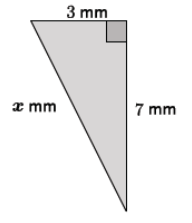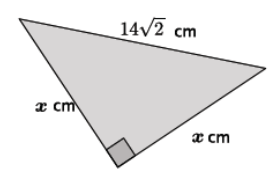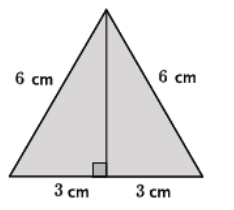Engage NY Eureka Math 8th Grade Module 7 Lesson 5 Answer Key
Eureka Math Grade 8 Module 7 Lesson 5 Example Answer Key
Example 1.
x3 + 9x = \(\frac{1}{2}\) (18x + 54)
Answer:
Now that we know about square roots and cube roots, we can combine that knowledge with our knowledge of the properties of equality to begin solving nonlinear equations like x3 + 9x = \(\frac{1}{2}\) (18x + 54). Transform the equation until you can determine the positive value of x that makes the equation true.
Challenge students to solve the equation independently or in pairs. Have students share their strategy for solving the equation. Ask them to explain each step.
x3 + 9x = \(\frac{1}{2}\) (18x + 54)
x3 + 9x = 9x + 27
x3 + 9x – 9x = 9x – 9x + 27
x3 = 27
\(\sqrt[3]{x^{3}}\) = \(\sqrt [ 3 ]{ 27 }\)
x = \(\sqrt[3]{3^{3}}\)
x = 3
Now, we verify our solution is correct.
33 + 9(3) = \(\frac{1}{2}\) (18(3) + 54)
27 + 27 = \(\frac{1}{2}\) (54 + 54)
54 = \(\frac{1}{2}\) (108)
54 = 54
Since the left side is the same as the right side, our solution is correct.
Example 2.
x(x – 3) – 51 = – 3x + 13
Answer:
Let’s look at another nonlinear equation. Find the positive value of x that makes the equation true: x(x – 3) – 51 = – 3x + 13.
Provide students with time to solve the equation independently or in pairs. Have students share their strategy for solving the equation. Ask them to explain each step.
Sample response:
x(x – 3) – 51 = – 3x + 13
x2 – 3x – 51 = – 3x + 13
x2 – 3x + 3x – 51 = – 3x + 3x + 13
x2 – 51 = 13
x2 – 51 + 51 = 13 + 51
x2 = 64
\(\sqrt{x^{2}}\) = ±\(\sqrt{64}\)
x = ±\(\sqrt{64}\)
x = ±8
Now we verify our solution is correct.
Provide students time to check their work.
Let x = 8.
8(8 – 3) – 51 = – 3(8) + 13
8(5) – 51 = – 24 + 13
40 – 51 = – 11
– 11 = – 11
Let x = – 8.
– 8( – 8 – 3) – 51 = – 3( – 8) + 13
– 8( – 11) – 51 = 24 + 13
88 – 51 = 37
37 = 37
Now it is clear that the left side is exactly the same as the right side, and our solution is correct.
Eureka Math Grade 8 Module 7 Lesson 5 Exercise Answer Key
Find the positive value of x that makes each equation true, and then verify your solution is correct.
Exercise 1.
a. Solve x2 – 14 = 5x + 67 – 5x.
Answer:
x2 – 14 = 5x + 67 – 5x
x2 – 14 = 67
x2 – 14 + 14 = 67 + 14
x2 = 81
\(\sqrt{x^{2}}\) = ±\(\sqrt{81}\)
x = ±\(\sqrt{81}\)
x = ±9
Check:
92 – 14 = 5(9) + 67 – 5(9)
81 – 14 = 45 + 67 – 45
67 = 67
( – 9)2 – 14 = 5( – 9) + 67 – 5( – 9)
81 – 14 = – 45 + 67 + 45
67 = 67
b. Explain how you solved the equation.
Answer:
To solve the equation, I had to first use the properties of equality to transform the equation into the form of x2 = 81. Then, I had to take the square root of both sides of the equation to determine that x = 9 since the number x is being squared.
Exercise 2.
Solve and simplify: x(x – 1) = 121 – x.
Answer:
x(x – 1) = 121 – x
x2 – x = 121 – x
x2 – x + x = 121 – x + x
x2 = 121
\(\sqrt{x^{2}}\) = ±\(\sqrt{121}\)
x = ±\(\sqrt{121}\)
x = ±11
Check:
11(11 – 1) = 121 – 11
11(10) = 110
110 = 110
– 11( – 11 – 1) = 121 – ( – 11)
– 11( – 12) = 121 + 11
132 = 132
Exercise 3.
A square has a side length of 3x inches and an area of 324 in2. What is the value of x?
Answer:
(3x)2 = 324
32 x2 = 324
9x2 = 324
\(\frac{9 x^{2}}{9}\) = \(\frac{324}{9}\)
x2 = 36
\(\sqrt{x^{2}}\) = \(\sqrt{36}\)
x = 6
Check:
(3(6)) 2 = 324
182 = 324
324 = 324
A negative number would not make sense as a length, so x = 6.
Exercise 4.
– 3x3 + 14 = – 67
Answer:
– 3x3 + 14 = – 67
– 3x3 + 14 – 14 = – 67 – 14
– 3x3 = – 81
\(\frac{ – 3 x^{3}}{3}\) = \(\frac{ – 81}{ – 3}\)
x3 = 27
\(\sqrt[3]{x^{3}}\) = \(\sqrt [ 3 ]{ 27 }\)
x = 3
Check:
– 3(3)3 + 14 = – 67
– 3(27) + 14 = – 67
– 81 + 14 = – 67
– 67 = – 67
Exercise 5.
x(x + 4) – 3 = 4(x + 19.5)
Answer:
x(x + 4) – 3 = 4(x + 19.5)
x2 + 4x – 3 = 4x + 78
x2 + 4x – 4x – 3 = 4x – 4x + 78
x2 – 3 = 78
x2 – 3 + 3 = 78 + 3
x2 = 81
\(\sqrt{x^{2}}\) = ±\(\sqrt{81}\)
x = ±9
Check:
9(9 + 4) – 3 = 4(9 + 19.5)
9(13) – 3 = 4(28.5)
117 – 3 = 114
114 = 114
– 9( – 9 + 4) – 3 = 4( – 9 + 19.5)
– 9( – 5) – 3 = 4(10.5)
45 – 3 = 42
42 = 42
Exercise 6.
216 + x = x(x2 – 5) + 6x
Answer:
216 + x = x(x2 – 5) + 6x
216 + x = x3 – 5x + 6x
216 + x = x3 + x
216 + x – x = x3 + x – x
216 = x3
\(\sqrt [ 3 ]{ 216 }\) = \(\sqrt[3]{x^{3}}\)
6 = x
Check:
216 + 6 = 6(62 – 5) + 6(6)
222 = 6(31) + 36
222 = 186 + 36
222 = 222
Exercise 7.
a. What are we trying to determine in the diagram below?

Answer:
We need to determine the value of x so that its square root, multiplied by 4, satisfies the equation
52 + (4\(\sqrt{x}\))2 = 112.
b. Determine the value of x, and check your answer.
Answer:
52 + (4\(\sqrt{x}\))2 = 112
25 + 42 (\(\sqrt{x}\))2 = 121
25 – 25 + 42 (\(\sqrt{x}\))2 = 121 – 25
16x = 96
\(\frac{16x}{16}\) = \(\frac{96}{16}\)
x = 6
The value of x is 6.
Check:
52 + (4\(\sqrt{6}\))2 = 112
25 + 16(6) = 121
25 + 96 = 121
121 = 121
Eureka Math Grade 8 Module 7 Lesson 5 Problem Set Answer Key
Find the positive value of x that makes each equation true, and then verify your solution is correct.
Question 1.
x2 (x + 7) = \(\frac{1}{2}\) (14x2 + 16)
Answer:
x2 (x + 7) = \(\frac{1}{2}\) (14x2 + 16)
x3 + 7x2 = 7x2 + 8
x3 + 7x2 – 7x2 = 7x2 – 7x2 + 8
x3 = 8
\(\sqrt[3]{x^{3}}\) = \(\sqrt [ 3 ]{ 8 }\)
x = 2
Check:
22 (2 + 7) = \(\frac{1}{2}\) (14(22 ) + 16)
4(9) = \(\frac{1}{2}\) (56 + 16)
36 = \(\frac{1}{2}\) (72)
36 = 36
Question 2.
x3 = 1331 – 1
Answer:
x3 = 1331 – 1
\(\sqrt[3]{x^{3}}\) = \(\sqrt[3]{1331^{ – 1}}\)
x = \(\sqrt[3]{\frac{1}{1331}}\)
x = \(\sqrt[3]{\frac{1}{11^{3}}}\)
x = \(\frac{1}{11}\)
Check:
(\(\left(\frac{1}{11}\right)^{3}\))3 = 1331 – 1
\(\frac{1}{11^{3}}\) = 1331 – 1
\(\frac{1}{1331}\) = 1331 – 1
1331 – 1 = 1331 – 1
Question 3.
Determine the positive value of x that makes the equation true, and then explain how you solved the equation.
\(\frac{x^{9}}{x^{7}}\) – 49 = 0
Answer:
\(\frac{x^{9}}{x^{7}}\) – 49 = 0
x2 – 49 = 0
x2 – 49 + 49 = 0 + 49
x2 = 49
\(\sqrt{x^{2}}\) = \(\sqrt{49}\)
x = 7
Check:
72 – 49 = 0
49 – 49 = 0
0 = 0
To solve the equation, I first had to simplify the expression \(\frac{x^{9}}{x^{7}}\) to x2. Next, I used the properties of equality to transform the equation into x2 = 49. Finally, I had to take the square root of both sides of the equation to solve for x.
Question 4.
Determine the positive value of x that makes the equation true.
(8x)2 = 1
Answer:
(8x)2 = 1
64x2 = 1
\(\sqrt{64^{2}}\) = \(\sqrt{1}\)
8x = 1
\(\frac{8x}{8}\) = \(\frac{1}{8}\)
x = \(\frac{1}{8}\)
Check:
(8(\(\frac{1}{8}\)))2 = 1
12 = 1
1 = 1
Question 5.
(9\(\sqrt{x}\))2 – 43x = 76
Answer:
(9\(\sqrt{x}\))2 – 43x = 76
92 (√x)2 – 43x = 76
81x – 43x = 76
38x = 76
\(\frac{38x}{38}\) = \(\frac{76}{38}\)
x = 2
Check:
(9(\(\sqrt{2}\)))2 – 43(2) = 76
92 (\(\sqrt{2}\))2 – 86 = 76
81(2) – 86 = 76
162 – 86 = 76
76 = 76
Question 6.
Determine the length of the hypotenuse of the right triangle below.

Answer:
32 + 72 = x2
9 + 49 = x2
58 = x2
\(\sqrt{58}\) = \(\sqrt{x^{2}}\)
\(\sqrt{58}\) = x
Check:
32 + 72 = (\(\sqrt{52}\))2
9 + 49 = 58
58 = 58
Since x = \(\sqrt{58}\), the length of the hypotenuse is \(\sqrt{58}\) mm.
Question 7.
Determine the length of the legs in the right triangle below.

Answer:
x2 + x2 = (14\(\sqrt{2}\))2
2x2 = 142 (\(\sqrt{2}\))2
2x2 = 196(2)
\(\frac{2 x^{2}}{2}\) = \(\frac{196(2)}{2}\)
x2 = 196
\(\sqrt{x^{2}}\) = \(\sqrt{196}\)
x = \(\sqrt{14^{2}}\)
x = 14
Check:
142 + 142 = (14\(\sqrt{2}\))2
196 + 196 = 142 (\(\sqrt{2}\))2
392 = 196(2)
392 = 392
Since x = 14, the length of each of the legs of the right triangle is 14 cm.
Question 8.
An equilateral triangle has side lengths of 6 cm. What is the height of the triangle? What is the area of the triangle?

Answer:
Note: This problem has two solutions, one with a simplified root and one without. Choose the appropriate solution for your classes based on how much simplifying you have taught them.
Let h cm represent the height of the triangle.
32 + h2 = 62
9 + h2 = 36
9 – 9 + h2 = 36 – 9
h2 = 27
\(\sqrt{h^{2}}\) = \(\sqrt{27}\)
h = \(\sqrt{27}\)
h = \(\sqrt{3^{3}}\)
h = \(\sqrt{3^{2}}\)×\(\sqrt{3}\)
h = 3\(\sqrt{3}\)
Let A represent the area of the triangle.
A = \(\frac{6(3 \sqrt{3})}{2}\))
A = 3(3\(\sqrt{3}\))
A = 9\(\sqrt{3}\)
Simplified: The height of the triangle is 3\(\sqrt{3}\) cm, and the area is 9\(\sqrt{3}\) cm2.
Unsimplified: The height of the triangle is \(\sqrt{27}\) cm, and the area is 3\(\sqrt{27}\) cm2
Question 9.
Challenge: Find the positive value of x that makes the equation true.
(\(\frac{1}{2}\) x)2 – 3x = 7x + 8 – 10x
Answer:
(\(\frac{1}{2}\) x)2 – 3x = 7x + 8 – 10x
\(\frac{1}{4}\) x2 – 3x = – 3x + 8
\(\frac{1}{4}\) x2 – 3x + 3x = – 3x + 3x + 8
\(\frac{1}{4}\) x2 = 8
4(\(\frac{1}{4}\)) x2 = 8(4)
x2 = 32
\(\sqrt{x^{2}}\) = \(\sqrt{32}\)
x = \(\sqrt{2^{5}}\)
x = \(\sqrt{2^{2}}\) ⋅ \(\sqrt{2^{2}}\) ⋅ \(\sqrt{2}\)
x = 4\(\sqrt{2}\)
Check:
(\(\frac{1}{2}\) (4\(\sqrt{2}\)))2 – 3(4\(\sqrt{2}\)) = 7(4\(\sqrt{2}\)) + 8 – 10(4\(\sqrt{2}\))
\(\frac{1}{4}\) (16)(2) – 3(4\(\sqrt{2}\)) = 7(4\(\sqrt{2}\)) – 10(4\(\sqrt{2}\)) + 8
\(\frac{32}{4}\) – 3(4\(\sqrt{2}\)) = 7(4\(\sqrt{2}\)) – 10(4\(\sqrt{2}\)) + 8
8 – 3(4\(\sqrt{2}\)) = (7 – 10)(4\(\sqrt{2}\)) + 8
8 – 3(4\(\sqrt{2}\)) = – 3(4\(\sqrt{2}\)) + 8
8 – 8 – 3(4\(\sqrt{2}\)) = – 3(4\(\sqrt{2}\)) + 8 – 8
– 3(4\(\sqrt{2}\)) = – 3(4\(\sqrt{2}\))
Question 10.
Challenge: Find the positive value of x that makes the equation true.
11x + x(x – 4) = 7(x + 9)
Answer:
11x + x(x – 4) = 7(x + 9)
11x + x2 – 4x = 7x + 63
7x + x2 = 7x + 63
7x – 7x + x2 = 7x – 7x + 63
x2 = 63
\(\sqrt{x^{2}}\)) = \(\sqrt{63}\)
x = \(\sqrt{\left(3^{2}\right)(7)}\)
x = \(\sqrt{3^{2}}\) ⋅ \(\sqrt{7}\)
x = 3\(\sqrt{7}\)
Check:
11(3\(\sqrt{7}\)) + 3\(\sqrt{7}\) (3\(\sqrt{7}\) – 4) = 7(3\(\sqrt{7}\) + 9)
33\(\sqrt{7}\) + 32 (\(\sqrt{7}\))2 – 4(3\(\sqrt{7}\)) = 21\(\sqrt{7}\) + 63
33\(\sqrt{7}\) – 4(3\(\sqrt{7}\)) + 9(7) = 21\(\sqrt{7}\) + 63
33\(\sqrt{7}\) – 12\(\sqrt{7}\) + 63 = 21\(\sqrt{7}\) + 63
(33 – 12) \(\sqrt{7}\) + 63 = 21\(\sqrt{7}\) + 63
21\(\sqrt{7}\) + 63 = 21\(\sqrt{7}\) + 63
21\(\sqrt{7}\) + 63 – 63 = 21\(\sqrt{7}\) + 63 – 63
21\(\sqrt{7}\) = 21\(\sqrt{7}\)
Eureka Math Grade 8 Module 7 Lesson 5 Exit Ticket Answer Key
Question 1.
Find the positive value of x that makes the equation true, and then verify your solution is correct.
x2 + 4x = 4(x + 16)
Answer:
x2 + 4x = 4(x + 16)
x2 + 4x = 4x + 64
x2 + 4x – 4x = 4x – 4x + 64
x2 = 64
\(\sqrt{x^{2}}\) = \(\sqrt{64}\)
x = 8
Check:
82 + 4(8) = 4(8 + 16)
64 + 32 = 4(24)
96 = 96
Question 2.
Find the positive value of x that makes the equation true, and then verify your solution is correct.
(4x)3 = 1728
Answer:
(4x)3 = 1728
64x3 = 1728
\(\frac{1}{64}\)(64x3) = (1728)\(\frac{1}{64}\)
x3 = 27
\(\sqrt[3]{x^{3}}\) = \(\sqrt [ 3 ]{ 27 }\)
x = 3
Check:
(4(3))3 = 1728
123 = 1728
1728 = 1728